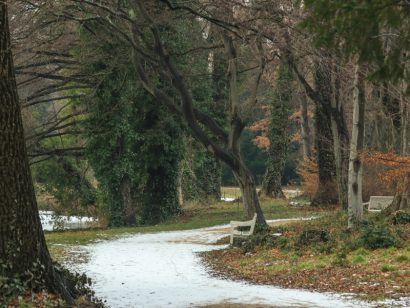
Festival of Lights Berlin
17 de September de 2016
The Bike Lanes in Berlin
1 de October de 2016Schloß Charlottenburg (Palace of Charlottenburg) is the largest palace in Berlin, built in the Italian Baroque style between the years 1695 and 1699 by architect Johann Arnold Nering at the request of Sophie Charlotte, wife of Prince Elector of Brandenburg, Friedrich III. Today the palace serves as a beautiful museum and is one of the most interesting attractions to visit in the city.
The initial name of the palace was Lietzenburg and was meant to be just a summer home for the Prussian royalty, which was later expanded and made into official residence. After Sophie’s death in 1705, her husband Friedrich III renamed the palace after his late wife.
In the following years there were several other changes and enlargements in the palace, as the inclusion of an impressive dome and a Orangerie, which is a type of garden structure from the Italian Renaissance, composed of arches under which they planted orange trees, to keep them protected in winter. Throughout this period the palace was adorned inside with imperial furniture, minute details in the paintings on the walls, real piece of arts on the ceilings and doors, as well as an enviable collection of cutlery and crockery.


Then there was a period of “abandonment” during the Friedrich Wilhelm I government, in which the building was casually used for official purposes and representation. After the king’s death in 1740, Friedrich the Great, chose the palace as his residence. At first, the residence designed by his grandmother, Sophie Charlotte, pleased him. However, the king ended up losing his interest in Chalottenburg and designed his own palace in Potsdam, named as Sanssouci, which means “no problem” or “no concern” in French.
During the government of Friedrich Wilhelm III, some rooms were renovated in the ceremonious style of late classicism and neorrococó. After the death of the king, the queen Elisabeth started to use the Palace of Charlottenburg as a residence. In the so-called “year of the Three Emperors” (1888), the palace served as the residence of King Friedrich III of Germany, which was in the terminal stage of their disease during the 99 days of his reign.



The palace was unfortunately partially destroyed during World War II and rebuilt after 1945. Since then the palace has become a major museum for German/Prussian history. A curious incident occurred between 2004 and 2006, when the German presidency moved to Charlottenburg, while Schloß Bellevue was under renovation.
The tour is only complete when the visitor steps in through the gardens and enjoys one of the most bucolic and beautiful scenery in city. For those who have already visited Vienna, you can have the same feeling while walking through the gardens of Belvedere or at Schönbrunn. During the warmer seasons, the garden is immaculate, with various species of flowers, a wonderful sight for the visitors. In the winter, the landscape changes dramatically, but remains still gorgeous!




At the end of the garden there is a lake called Karfenteich that turns the scene into a fairy tale. The statues of little angels on the border of the lake, the ducks, a romantic bridge in the background. No doubt, a very special place. The best part is that the access to the gardens is free of charge!
The site is widely used by neighborhood residents, whether for sports, since it is a green area located on the River Spree embankment, or to relax and enjoy all the wealth palace details.
Source: Schloß Charlottenburg, Berin – Fondation Paribas.
The access can be done by metro lines U2, station Sophie Charlotte or by line U7, station Richard-Wagner-Platz.
The opening hours are from Tuesday to Sunday from 10 am to 6 pm.


